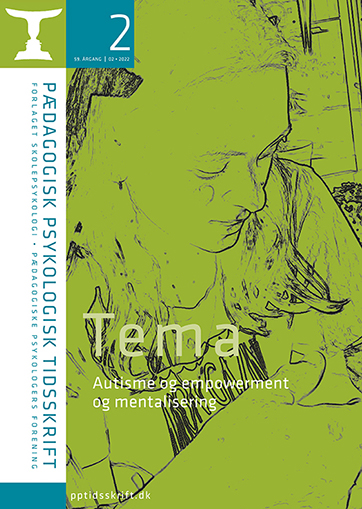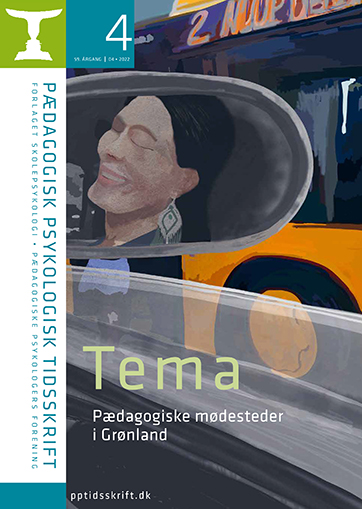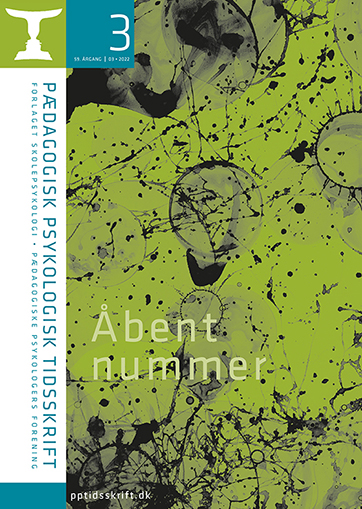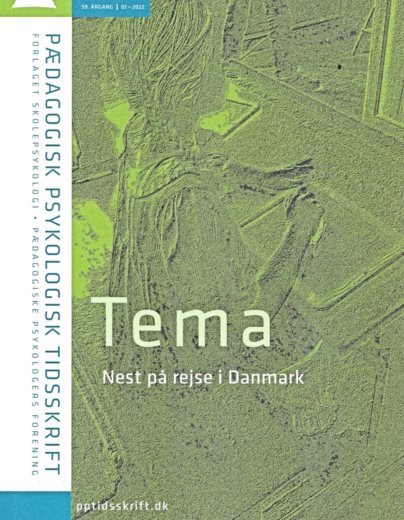Beskrivelse
A way to develop the specialised profession
By Tina Humlebæk and Tina Weng
This article is based on the PD-project “A way to develop the specialized profession – in special schools for children of average intelligence with autism spectrum disor- ders . The article deals with a new way for the specialized profession to intervene by using the latest neuropsychological knowledge and different pedagogical ap- proaches . Moreover, the article emphasizes the importance of destigmatizing the child and not looking at the child as being the problem .
To secure the very best development for the child with autism spectrum disorder, the article looks into what it takes to make neuropsychological knowledge and diffe- rent pedagogical approaches to become an active part of the tools of the profession instead of being a passive knowledge . The article emphasizes always looking for ways and to develop the child, and to be looking for potentials in the child . It focu- ses on the importance of the profession having the latest neuropsychological know- ledge and having a broad option of approaches and time and room for reflection and dialouges about the practice . The article concludes the need of creating the best possible set-up for this knowledge to be incorporated alive in the daily practice . This article will open up for ministries and schools to start maximising the know- ledge of the profession during lectures and by creating the right structure for the profession to develop and optimize their practice within .
Supporting young people with autism in their transition to adulthood
By Helle Nyhuus, Lea Grønfeldt and Mette Lindgaard
Motivated by the increasing number of young people with autism, several munici- palities in Denmark have initiated social interventions . A social intervention was created based on the knowledge generated by these existing interventions and scientific articles on the subject . The objective is to support young people with autism in their transition to adulthood . The social intervention consists of five core elements . The first three elements involve ensuring adequate coordination, making the young person, as well as their parent(s), a part of the process of clarifying needs and wishes and also creating a clear plan together with the young person . The last two elements are extensive individual support by a professional and a series of group sessions . These group sessions focus on different life skills ranging from in- terpersonal communication, and conflict management, to maintaining friendships
148 Pædagogisk Psykologisk Tidsskrift
and how to spend your spare time . Group sessions can also be facilitated for the pa- rents to help them support their young person and as a space for sharing experi- ences . The knowledge gained so far shows that the needs of the participants vary considerably, as does their capacity to participate in group sessions and their abili- ty to employ skills in their everyday life . Furthermore, it has become apparent that the connection between the group sessions and real-life employment of life skills is increased if the person in charge of facilitating group sessions also performs indivi- dual support . Networking also needs to be prioritised if skills are to be maintained long-term . Thus far, the most common concerns raised in group sessions are pro- blems generally associated with the transition to adulthood .
PDA – a contemporary perspective in ASD counselling
By Christian A. Stewart-Ferrer
One of several ‘profiles’ within the autism spectrum is PDA – Pathological Demand Avoidance . It was originally described by the late Elizabeth Newson early in the 1980s but seemed to lose traction in later years – after the appearance of the ICD- 10 and the DSM-IV – only to re-emerge during the last decade in a revised and mo- dern conceptualisation under the auspices of Elizabeth O’Nions .
Both the essence and the pertinence of PDA remain disputed, but when seen in context, PDA seems to add crucially to our understanding not merely of the challen- ges faced by people living with autism spectrum disorders (ASD) but also of some of the solutions to said challenges .
The purpose of this article is to trace the history and present form of PDA and to call attention to essential facets of ASD revealed by PDA, as well as to the incre- ased clarity of perspective thus obtained regarding intervention .
How can a mentalisation-based approach be developed to enable autistic children to strengthen their self-agency, affective relational competencies, and mentalising capabilities?
By Mette Kyung
This paper asks, how can a mentalisation-based approach be developed to enable autistic children to strengthen their self-agency, affective relational competencies, and mentalising capabilities? The author aims to initiate renewed thinking among those working with children and adolescents with autism . The mentalisation-based approach is a theoretical and developmental psychological framework that can ser- ve as a supplementary developmental focus in our approach and interventions with this group . The author hopes to inspire psychologists and other professionals to keep an ongoing focus on developmental support by showing how their direct men- talisation-based interaction enhances the mentalising capabilities of children and
Nr. 2 – 2022 149
adolescents with autism . The author has more than two decades of clinical practice with this group, carrying out assessments and interventions with all ages, as well as counselling families and supervising and training professionals .
Coming to ‘terms’ with autism: Making sense of the key linguistic debates
By Dr Rob Begon and Dr Damian Milton
Approaches that adopt a critical stance towards established models of autism tend to assume that the language we use (when talking about autism) is productive . That is to say, language is not merely a means by which to codify our understan- dings of autism but rather a powerful epistemological tool that underpins our very systems of knowing . Then, the discourses available within a society dictate what can be known about autism and actively construct what comes to be accepted as truth . Therefore, it may be said that different ‘versions’ of autism have been, and continue to be, constructed through language . This takes us away from the idea of autism as a single, axiomatic truth and instead frames it as a fluid concept, inextri- cably linked to our conceptual schemes, perceptions and linguistic practices .
Narrative psychoeducation. Co-creating useful advice for parents of auti- stic children.
By Nina Tejs Jørring
Narrative psychoeducation is developed transdiagnostic for spontaneous and plan- ned conversations that can help professionals co-create knowledge with parents of children with a psychiatric illness .
When different aspects of autism are obstacles to preferred family life, the five- step model supports a systematic and transparent scaffolding . The model focuses on providing knowledge about the appropriate problem at the right time and at the right amount according and attuned to the parents’ feelings and thoughts .
The model can be used as a recipe from a cookbook that can be followed stepwise for a beginner and as inspiration for the experienced . The starting point is the pa- rents’ description of their perceived problem . The helper relates this to a psychiatric understanding of autism and translates and conveys her professional knowledge using the parents’ words, focusing on co-creating mutual understanding by explo- ring the parents’ understanding of the proposed psychiatric explanation . The next step relates this understanding of the parents’ previous experiences and skills in handling the explored problem . The new knowledge will be further cemented through a re-telling . A metaphor can be used to condense this knowledge, so the pa- rents will experience it as a technique that can be used in different contexts, enhan- cing their experience of parental agency .
150 Pædagogisk Psykologisk Tidsskrift
The correlation between school absenteeism, anxiety, and autism.
By Tine Basse Fisker
This article discusses the correlation between school absenteeism, anxiety, and autism . The reflections are illustrated via the case study of Ea, a girl who did not attend school for five years . Ea was never diagnosed with autism, but after this diagnosis was suggested, it became the primary focus of Ea’s treatment with vari- ous professionals . However, she is also described as also having severe OCD and anxiety . In the article, autism is discussed as a diagnosis that produces a specific pedagogical response: Ea’s parents were advised to react to this diagnosis by redu- cing Ea’s stress and minimising the sensory input and demands placed on her . This perspective dominates all approaches to Ea’s care and blurs the effects that anxiety and OCD have on her life . It is suggested to call this effect “categorical blurring”, which is problematic because addressing only her (suggested) autism means that the avoidant behaviour elicited by the anxiety disorder is never challenged by expo- sure to the feared situations . This article discusses that the consequence of this ca- tegorical blurring is a non-treatment approach to Ea’s anxiety disorder, and there- fore, she makes no progress toward attending school .
What is the Danish Health Authority’s National Clinical Guideline?
By Dorte Bek-Pedersen, Specialist Psychologist in Child and Adolescent Psychiatry, Centre for Autism
In spring 2021, the Danish Health Authority published for the first time the Natio- nal Clinical Guideline for the Treatment of Autism Spectrum Disorder in Children and Adolescents . The purpose of the guideline is to identify specific treatment opti- ons concerning a number of selected clinical issues (“point reductions”) within the autism field . This promotes consistent quality and practice in treatment and provi- sion, primarily in the health system . The guideline thus focuses on forms of inter- vention within the field of autism, which in practice are currently accessed and used to varying degrees by professionals across the country .
Dynamic efforts for families with children and adolescents on the autism spectrum in the City of Copenhagen
By Heide Holm Vedel, Kis Steen, Bettina Råschou, Christine Pejstrup Petersen and Elly Mørkeberg
In the City of Copenhagen, there has been a steady increase in the number of children and teenagers with an autism diagnosis and an understanding of the com- plexity of the difficulties families face has increased . This has meant that the Citi- zen Centre for People with Disabilities (Borgercenter Handicap) has had to look at
Nr. 2 – 2022 151
the intervention plan and develop flexible and dynamic offers for the target group . The offers at the Agency of Family Law (Familiehuset) have had to accommodate various support offers seen over time in a family . At times, there may be a need for massive support, and at other times the need is much smaller, and it will be suffi- cient with a here and now counselling without having to go through an actual visi- tation process . At the intervention stage, it has been important, not only to focus on mastering one’s own life or reducing an anxiety problem, but to a large extent also to work with the autism-specific difficulties in the offer .
Moving into new territories of understanding oneself – conversations about autism seen through social-constructionistic and narrative lenses
By Julie Rysgaard Tamakloe
With this article, I want to bring two worlds together at the intersection of the world of expertise and my social-constructionistic and narrative point of departure . In my experience, there is huge potential to be used both by taking inspiration from the many theories about autism and at the same time being firmly grounded in the desire to talk about, expand, and enhance a person’s own understanding of life, sin- ce nothing is static and fixed . This article includes small examples from practices to illustrate this . My hope is that this article will contribute to the curiosity and zeal of professionals as opposed to the reluctance and worry of not having sufficient knowledge, which I seem to encounter in the field . Furthermore, in this article, I take a critical look at how externalising practices are used in the field of autism .
I argue why I believe we might end up using them as a power tool – directly contra- ry to Michael White’s intentions .



